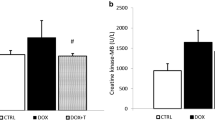Abstract
Treatment of HIV with AZT (zidovudine) may have toxic side effects as a result of multiple mechanisms. It is known that patients with AIDS may suffer from magnesium deficiency (MgD). We studied selected biochemical and histopathologic consequences of AZT administration (0.7 mg/mL in drinking water) with concurrent Mg-deficient (20% of normal) diet in male C57BI/6N mice for 3 wk. Significant decreases in red blood cell glutathione (GSH) were evident in the Mg-deficient mice with or without AZT treatment, suggesting compromised antioxidant capacity in the blood. Although MgD alone led to a 1.9-fold increase in plasma thromboxane B2 (TXB2, derived from the highly vasoconstrictive TXA2), AZT+MgD increased the TXB2 level 3.5-fold. AZT (±MgD) provoked prominent hepatic damage expressed by distortion of lobular architecture, nuclear and cellular swelling, and inflammatory lesions and loss of hepatocytes. AZT alone caused mild cardiac lesions, resulting in partial cardiac fibrosis, especially in the atrium. AZT+MgD caused only scattered small-size cardiac lesions consisting of microscopic foci of inflammatory infiltrates in the ventricles but led to more prominent lesions, fibrosis, and scars in the atrium. MgD or AZT alone caused varying degrees of skeletal muscle degeneration; in combination, more intense degeneration and regeneration of muscle cells were evident. In conclusion, it is suggested that both the decreased blood GSH and elevated plasma TXA2 might contribute, at least in part, to the aggravated pathological damages observed in the atrium and skeletal muscle of the AZT-treated Mg-deficient mice.
Similar content being viewed by others
References
Lewis, W., Copeland, W.C., and Day, B.J. (2001). Mitochondrial DNA depletion, oxidative stress, and mutation: mechanisms of dysfunction from NRTIs. Lab. Invest. 81: 777–790.
Pezeshkpour, G., Illa, I., and Dalakas, M.C. (1991). Ultrastructural characteristics and DNA immunocytochemistry in HIV and zidovudine-associated myopathies. Hum. Pathol. 22:1281–1288.
Koduri, P.R. and Parekh, S. (2003). Zidovudine-related anemia with reticulocytosis. Ann. Hematol. 82:184–185.
Koch, R.O., Graziadei, W., and Zangerle, R. (2003). Acute hepatic failure and lactate acidosis associated with antiretroviral treatment for HIV. Wien. Klin. Wochenschr. 115: 135–140.
Olano, J.P., Borucki, M.J., Wen, J.W., and Haque, A.K. (1995). Massive hepatic steatosis and lactic acidosis in a patient with AIDS who was receiving zidovudine. Clin. Infect. Dis. 21:973–976.
Brod-Miller, C. (1990). Hypomagnesemia (HMg) in acquired immune deficiency syndrome (AIDS). J. Am. Soc. Nephrol. 1:329–331.
Patrick, L. (2000). Nutrients and HIV: part two—vitamins A and E, zinc, B-vitamins, and magnesium. Altern. Med. Rev. 5:39–51.
Lacey, R.F. and Shaper, A.G. (1984). Changes in water hardness and cardiovascular death rates. Int. J. Epidemiol. 13:18–24.
Ledingham, J.G. and Raine, A.E. (1996). The treatment of heart failure: diuretics, in Oxford Textbook of Medicine, 3rd ed. (Weatherall, D.J., Ledingham, J.G., and Warrell, D.A., eds.) Oxford University Press, New York, pp 2238–2241.
Shils, M.E. (1996). Magnesium, in Present Knowledge in Nutrition, 7th ed. (Ziegler, E.E. and Filer, L.J. Jr., eds.), ILSI Press, Washington, DC, pp 256–264.
Mak, I.T., Komarov, A.M., Wagner, T.L., Stafford, R.E., and Weglicki, W.B. (1996). Enhanced NO production during Mg-deficiency and its role in mediating red blood cell glutathione loss. Am. J. Physiology 271:C385-C390.
Vormann, J., Gunther, T., Hollriegl, V., and Schumann, K. (1998). Pathobiochemical effects of graded Mg-deficiency in rats. Z. Ernahrungswiss. 37(Suppl 1):92–97.
De la Asuncion, J.G., del Olmo, M.L., Sastre, J., Pallardo, F.V., and Vina, J. (1999). Zidovudine (AZT) causes anoxidation of mitochondrial DNA in mouse liver. Hepatology 29:985–987.
Weglicki, W.B., Mak, I.T., Kramer, J.H., Dickens, B.F., Cassidy, M.M., Stafford, R.E., et al. (1996). Role of free radicals and substance P in Mg-deficiency. Cardiovasc. Res. 31:677–682.
Freedman, A.M., Mak, I.T., Stafford, R.E., Dickens, B.F., Cassidy, M.M., Muesing, R.A., et al. (1992). Erythrocytes from MgD hamsters display an enhanced susceptibility to oxidative stress. Am. J. Physiol. 262:C1371-C1375.
Mak, I.T., Stafford, R.E., and Weglicki, W.B. (1992). Loss of RBC glutathione during Mg-deficiency: prevention by vitamin E,D-propranolol and chloroquine. Am. J. Physiol. 267:C1366-C1370.
Belton, O., Byrne, D., Kearney, D., Leahy, A., and Fitzgerald, D.J. (2000). Cyclooxygenase-1 and 2-dependent prostanoid formation in patients with atherosclerosis. Circulation 102:840–845.
Ruga, E., Bova, S., Nussdorfer, G., Mazzocchi, G., Rebuffar, P., Milanesi, O., et al. (2003). Zidovudine-induced alterations in the heart and vascular smooth muscle of the rat. Cardiovasc. Res. 60:147–155.
Laurant, P., Hayoz, D., Brunner, H.R., and Berthelot, A. (1999). Effect of Mg deficiency on blood pressure and mechanical properties of rat carotid artery. Hypertension 33:1105–1110.
Masini, A., Scotti, C., Calligaro, A., Cazzalini, O., Stivala, L.A., Bianchi, L., et al. (1999). Zidovudine-induced experimental myopathy: dual mechanism of mitochondrial damage. J. Neurol. Sci. 166:131–140.
Jurjus, A.R., Walsh, R.J., Weglicki, W.B., and Correa-de-Araujo, R. (1998). Increase in the expression of substance P receptors in the atria of Mg-deficient rats. Cardiovasc. Pathol. 2:199–206.
Morse, D.E., Davis, H.D., Popke, E.J., Brown, K.J., O'Donoghue, V.A., and Grunberg, N.E. (1997). Effects of ddC, AZT on locomotion and acoustic startle. I. Acute effects in female rats. Pharmacol. Biochem. Behav. 56: 221–228.
Dalakas, M.C. (2001). Peripheral neuropathy and antiretroviral drugs. J. Peripher. Nerv. Syst. 6:14–20.
Author information
Authors and Affiliations
Corresponding author
Rights and permissions
About this article
Cite this article
Mak, I.T., Goldfarb, M.G., Weglicki, W.B. et al. Cardiac pathologic effects of azidothymidine (AZT) in Mg-deficient mice. Cardiovasc Toxicol 4, 169–177 (2004). https://doi.org/10.1385/CT:4:2:169
Received:
Revised:
Accepted:
Issue Date:
DOI: https://doi.org/10.1385/CT:4:2:169




